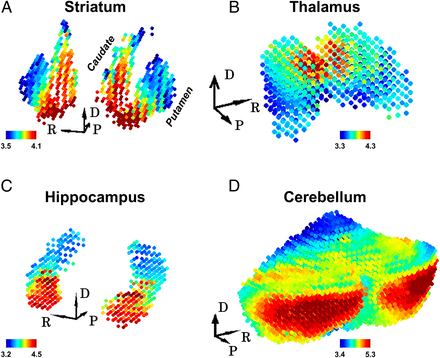Friday, 26 November 2021
Study on the intrinsic, dynamic activity of the brain confirms a very general principle of its organization
 Scientists have known for some time that for our brains to perform any given task, a very short-term sensory memory function must co-operate with some of our longer-term memory functions. Scientists have also known that such encoding on various time scales is correlated with the frequencies at which the neurons oscillate in the associated parts of our brain, ranging from high frequencies in the sensory cortical areas to very low frequencies in the multi modal associative areas. But in an article entitled Hierarchical dynamics as a macroscopic organizing principle of the human brain, published in the journal PNAS in August 2020, authors Ryan Raut, Abraham Snyder and Marcus Raichle showed that this important principle can be generalized not only to the entire cortex, but also to several sub-structures within it. Throughout all of them, the temporal profile of the spontaneous oscillations in the brain seems to be structured along gradients starting in the high-frequency sensory areas and proceeding to multi modal, higher-function areas where the oscillation frequencies are far lower.
Scientists have known for some time that for our brains to perform any given task, a very short-term sensory memory function must co-operate with some of our longer-term memory functions. Scientists have also known that such encoding on various time scales is correlated with the frequencies at which the neurons oscillate in the associated parts of our brain, ranging from high frequencies in the sensory cortical areas to very low frequencies in the multi modal associative areas. But in an article entitled Hierarchical dynamics as a macroscopic organizing principle of the human brain, published in the journal PNAS in August 2020, authors Ryan Raut, Abraham Snyder and Marcus Raichle showed that this important principle can be generalized not only to the entire cortex, but also to several sub-structures within it. Throughout all of them, the temporal profile of the spontaneous oscillations in the brain seems to be structured along gradients starting in the high-frequency sensory areas and proceeding to multi modal, higher-function areas where the oscillation frequencies are far lower.
These findings are interesting for reasons that vary from one part of the brain to another. With regard to the cortex, they confirm all sorts of other studies suggesting the existence of such a gradient, which also happens to match the way we subjectively experience the world. To follow the constant, extremely rapid changes that occur in our environment, we do not need to remember their tiniest fluctuations. Imagine yourself walking along a tree-lined lakeshore on a beautiful, windy summer day. Everything around you is moving—the leaves, the trees, the reflections on the water, the trail that passes beneath your feet as you walk along, and so on—but you’re never going to remember all those details. However, if the sky suddenly clouds up and you start hearing thunder, you might well dig into your long-term memory, recall that these are signs of an approaching storm, and come up with a plan A or a plan B in case it starts to rain hard. All of these fairly high-level mental-simulation processes involve much lower brain-wave frequencies.
But this study’s most important new contribution is to show that even though the main sub-cortical structures in the brain—the striatum, thalamus, cerebellum and hippocampus—differ greatly from one another in their neuronal architecture and functional anatomy, they all seem to be organized along such gradients in the frequency of dynamic neural activity, which they generate spontaneously. The illustration at the top of this post shows how these gradients are manifested spatially in each of these four structures. Moreover, these gradients reflect exactly what we already know about the functional organization of each of these structures. This study thus sheds light on some principles of the organization of the human brain that appear to be very general and that involve the dynamic aspect of neural activity, which researchers too often neglect.
From the Simple to the Complex | Comments Closed







